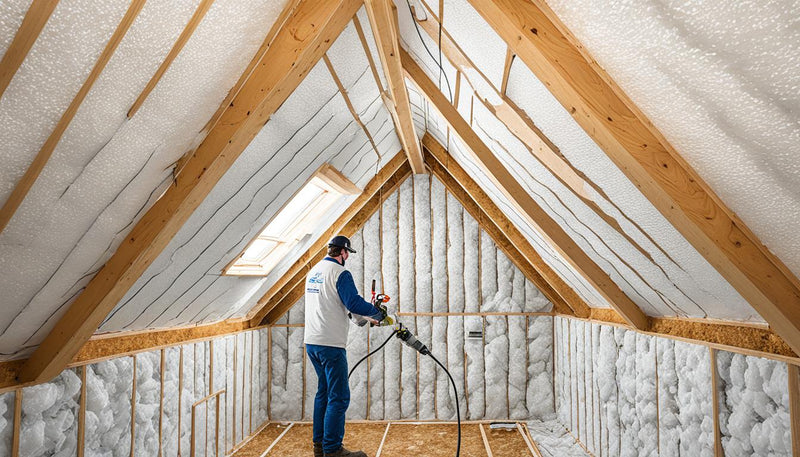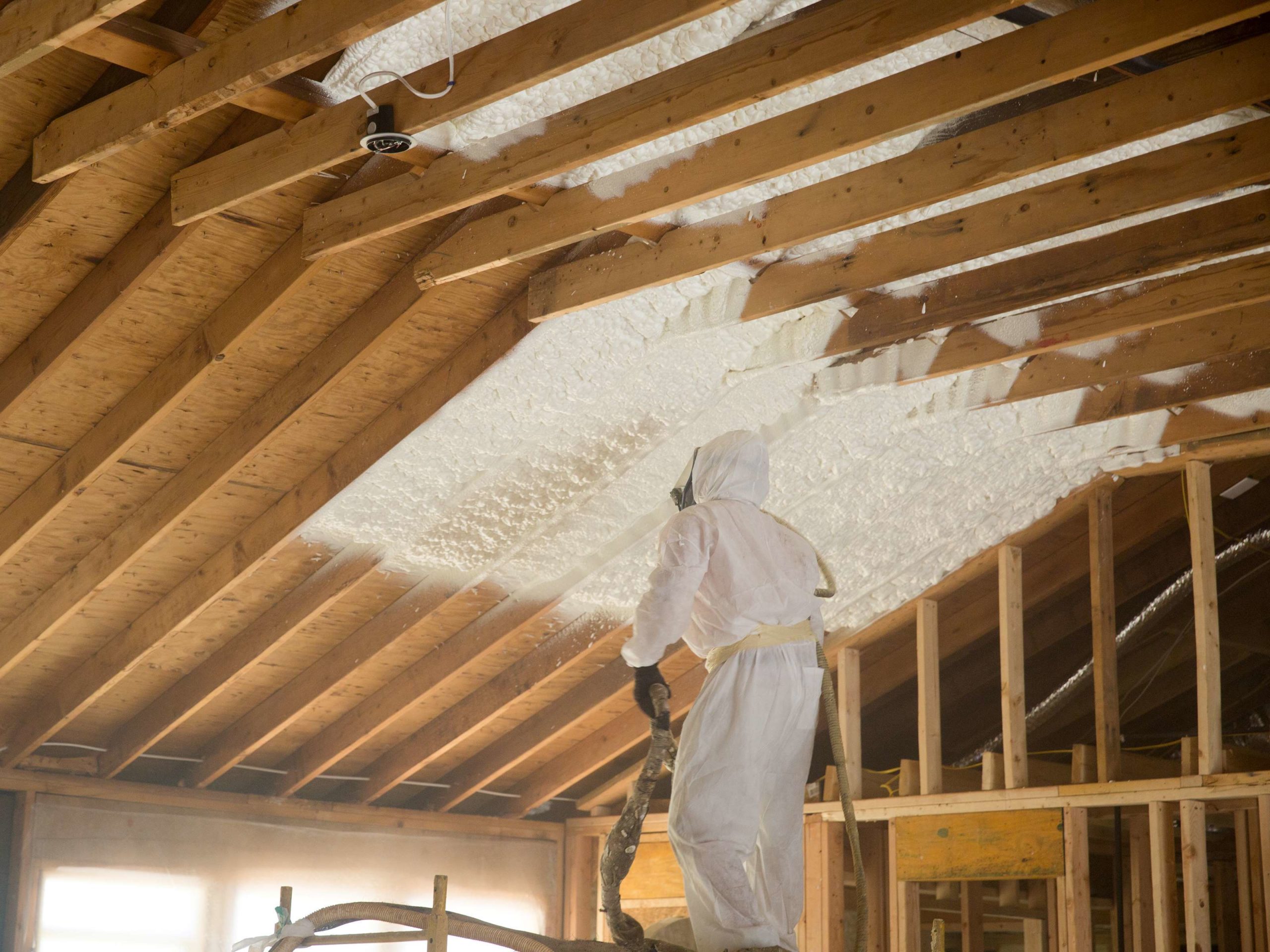The Environmental Impact of Spray Foam: Sustainability Considerations
The Environmental Impact of Spray Foam: Sustainability Considerations
Blog Article
Just How Spray Foam Can Enhance Energy Effectiveness in Any Kind Of Building
Spray foam insulation has actually become a crucial service for boosting energy effectiveness throughout numerous building types. By developing an impermeable seal that decreases air leakage, it properly manages indoor climates while dramatically reducing heating and cooling expenses. In addition, its impressive R-value and moisture-resistant properties contribute to long-lasting power financial savings and improved building durability. As property owners significantly seek sustainable options, the effects of spray foam insulation extend beyond simple utility savings. The full extent of its advantages, however, warrants a better evaluation of exactly how it can transform energy administration methods in both commercial and residential setups.
Recognizing Spray Foam Insulation
Spray foam insulation is increasingly identified for its exceptional thermal performance and flexibility in different applications. Made up primarily of polyurethane, this insulation material is applied as a liquid that broadens upon get in touch with, filling up voids and developing a seamless barrier. This special residential or commercial property allows spray foam to satisfy uneven surface areas, making it a perfect choice for both commercial and residential frameworks.

Application of spray foam insulation is usually performed by qualified experts making use of specific tools, making sure optimal efficiency and security - Spray Foam. The healing procedure is fast, allowing for quick setup and minimal disruption. As a result, spray foam insulation is significantly being used in new building and construction and retrofitting tasks due to its ability to enhance structural stability while enhancing general energy performance in structures
Benefits of Energy Efficiency
Energy efficiency plays a critical role in reducing operational costs and minimizing ecological impact throughout numerous fields. By maximizing power usage, property owners and services can achieve considerable cost savings on utility bills, which directly improves monetary efficiency. Effective power consumption indicates much less reliance on nonrenewable fuel sources, thus contributing to a decrease in greenhouse gas exhausts and promoting an extra lasting atmosphere.
In addition, energy-efficient buildings typically experience enhanced property worths. As energy costs climb and sustainability becomes a priority for consumers, residential properties with improved energy performance functions are extra appealing on the market. This pattern encourages investment in energy-saving technologies, which can even more drive innovation and economic development.
In addition to financial and environmental benefits, energy effectiveness can also enhance the overall convenience and health and wellness of indoor areas. Appropriate insulation and reliable heating & cooling systems aid preserve constant temperature levels, reducing drafts and humidity degrees, which subsequently can result in much better interior air quality.
Ultimately, the advantages of power efficiency prolong past prompt cost savings, fostering a resistant economic climate, promoting ecological stewardship, and enhancing the lifestyle for passengers in any type of building.
Exactly How Spray Foam Functions
Normally used as a liquid, spray foam broadens quickly upon call with surfaces, developing a strong barrier that effectively secures cracks and spaces. This unique residential or commercial property results from its chemical make-up, primarily consisting of polyols and isocyanates, which react when mixed to create a foam that fills up spaces and sticks to different materials, including metal, wood, and concrete.
Once used, the foam expands to several times its initial quantity, guaranteeing a tight seal that prevents air leak. This procedure dramatically minimizes thermal connecting, which happens when warm transfers with materials, leading to energy loss. The foam's high R-value, a measure of thermal resistance, adds to enhanced insulation by reducing heat transfer in between the exterior and interior settings.
Furthermore, spray foam is resistant to moisture and parasites, additionally enhancing its efficiency in preserving power effectiveness. Its application can be tailored to various areas, consisting of attic rooms, walls, and crawl rooms, maximizing insulation across a structure. Spray Foam. Generally, the innovative layout and application technique of spray foam make it an effective option for improving power efficiency in any kind of structure, resulting in decreased energy expenses and a more sustainable built environment

Applications in Various Structures
Countless applications of spray foam insulation can be located across different building types, boosting power effectiveness and convenience. In household homes, spray foam is typically utilized in walls and attic rooms to produce page a smooth obstacle versus air leakages, substantially reducing home heating and cooling down demands. This application is especially advantageous in older homes, where traditional insulation may be poor.
In business structures, spray foam insulation is used to roof covering systems and exterior wall surfaces, which helps to boost thermal performance and safeguard against moisture breach. Its lightweight nature makes it a suitable selection for retrofitting existing frameworks without adding substantial weight. Furthermore, spray foam can be used in commercial setups to protect pipes and tank, preserving temperature control for sensitive products.
Institutional buildings, such as schools and health centers, gain from spray foam insulation by making sure a regular interior climate that supports owner comfort and wellness. The convenience of spray foam permits it to adjust to different structure forms and dimensions, making it a preferred selection for architects and builders looking for reliable insulation options. In general, spray foam insulation acts as an important element in achieving energy-efficient structures throughout all fields.
Long-Term Cost Savings
Spray foam insulation uses significant long-lasting cost financial savings for building owners and passengers by minimizing energy intake and reducing energy expenses. By providing a superior air seal, spray foam minimizes the infiltration of outside air, thus enhancing the thermal performance of a structure. This results in extra efficient home heating and cooling procedures, which can cause considerable reductions in energy costs with time.
In enhancement to immediate cost savings on energy bills, the toughness and long life of spray foam insulation add to its monetary benefits. Unlike conventional insulation products, which may sag, resolve, or weaken, spray foam keeps its effectiveness for years, reducing the requirement for constant replacements or fixings. This longevity equates to decrease maintenance expenses and much less disruption for residents.
In addition, structures geared up with spray foam insulation commonly appreciate an increase in property value, making them much more enticing to possible original site customers or renters. As energy effectiveness comes to be increasingly prioritized, buildings with effective insulation services attract attention in the market. Ultimately, the integration of spray foam insulation not only enhances comfort but likewise represents a tactical investment that generates considerable economic benefits over the long term.
Conclusion
Finally, spray foam insulation offers as a vital element in boosting power performance across diverse building kinds. Its ability to develop a smooth barrier against air leak, incorporated with moisture-resistant buildings and high r-values, dramatically lowers power usage and associated prices. The execution of spray foam not only adds to regular interior temperatures but also raises property worth, highlighting its function as a sensible financial investment for both property and industrial residential properties.
Spray foam insulation has emerged as a pivotal solution for boosting energy efficiency throughout numerous building types. Spray Foam. As an outcome, spray foam insulation is progressively being utilized in new building and construction and retrofitting jobs due to its ability try this website to improve structural integrity while boosting general energy performance in structures
On the whole, the cutting-edge layout and application approach of spray foam make it an efficient option for enhancing energy effectiveness in any framework, leading to reduced power prices and an extra sustainable developed atmosphere.
Numerous applications of spray foam insulation can be located throughout numerous building types, improving power effectiveness and comfort.In conclusion, spray foam insulation serves as a vital element in enhancing energy efficiency throughout diverse structure types.
Report this page